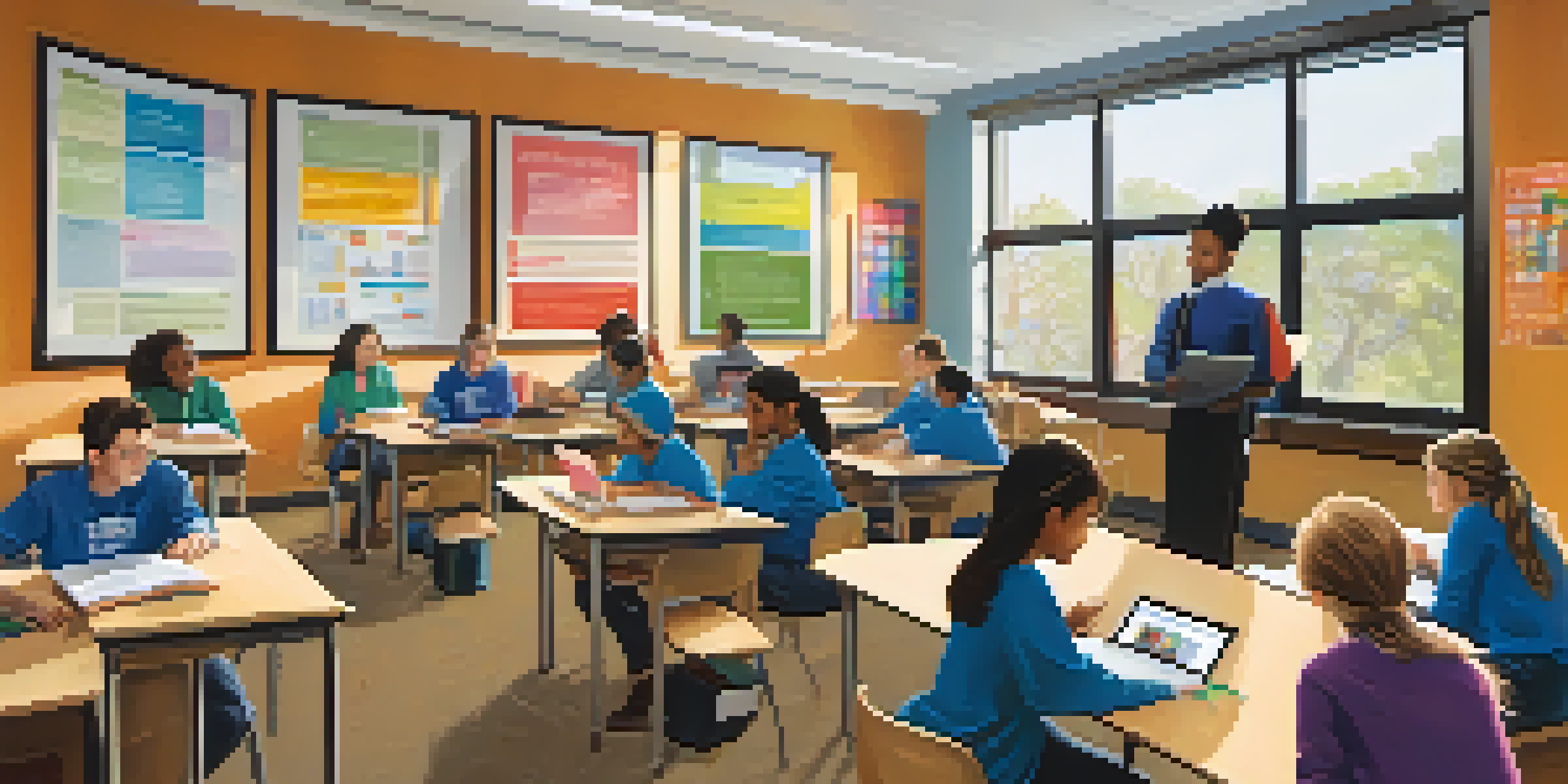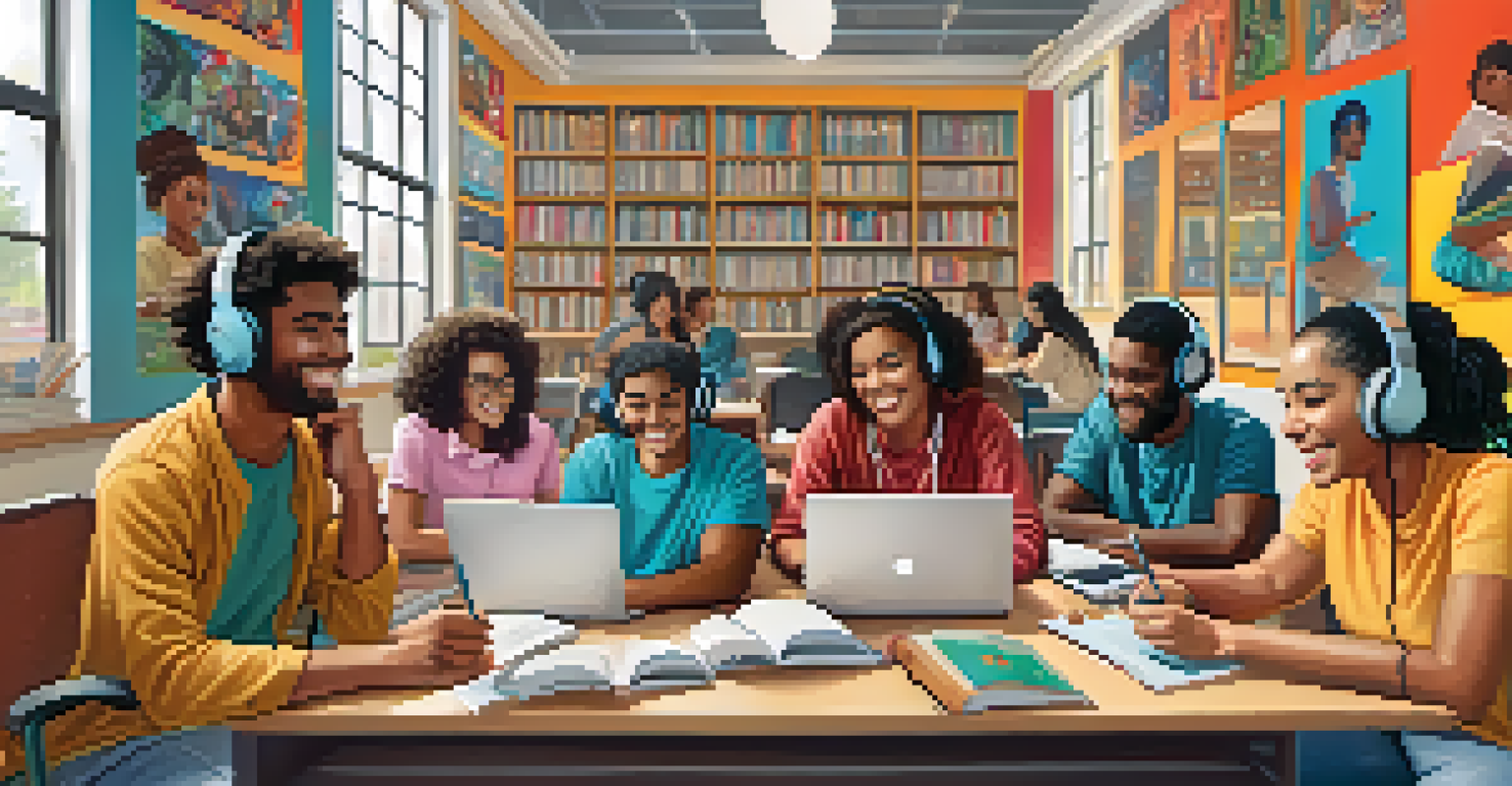Exploring the Role of Podcasts in Blended Learning

Understanding Blended Learning: A Quick Overview
Blended learning combines traditional face-to-face education with online learning components. This flexible approach allows educators to tailor their teaching methods to suit diverse student needs. Imagine a classroom where students can engage with materials at their own pace while still benefiting from in-person discussions. This model not only enhances learning but also prepares students for a digital world.
Blended learning combines the best of both worlds, allowing students to learn at their own pace while still benefiting from personal interaction.
At its core, blended learning aims to create a more personalized learning experience. By incorporating various educational tools, instructors can foster a more engaging atmosphere that encourages participation. Think of it as mixing ingredients in a recipe; the right combination can yield a delicious dish that satisfies everyone's taste buds.
As technology continues to evolve, so does the landscape of education. Blended learning is increasingly becoming a go-to solution for many institutions looking to innovate their teaching methods. In this context, podcasts have emerged as a valuable resource that can further enrich the blended learning experience.
The Rise of Podcasts in Education
Podcasts have exploded in popularity over the past few years, offering a convenient way to consume content on the go. They provide an excellent medium for educators to share knowledge and insights, allowing students to learn anytime and anywhere. Just think about how easy it is to listen to a podcast while commuting or exercising; this flexibility makes learning more accessible.

Educational podcasts can cover a wide range of topics, from complex theories to practical advice, catering to different learning styles. They often feature expert interviews or discussions, providing students with diverse perspectives that can enhance their understanding. This variety not only keeps learners engaged but also encourages critical thinking by exposing them to different viewpoints.
Blended Learning Enhances Personalization
Blended learning combines traditional and online education, allowing for a tailored approach that meets diverse student needs.
Moreover, the rise of podcasts signifies a shift in how information is consumed and processed. As students become more accustomed to auditory learning, educators must adapt their strategies to leverage this medium. Integrating podcasts into blended learning environments can create a more dynamic and effective educational experience.
Enhancing Engagement Through Storytelling
One of the most powerful aspects of podcasts is their ability to tell stories in a compelling way. When educators share real-life experiences or case studies, they can capture students' attention and make complex concepts relatable. Think of a captivating story as a bridge that connects theoretical knowledge to practical application.
Podcasts have the power to make learning not just accessible, but engaging and enjoyable.
Storytelling not only makes learning more enjoyable but also helps students retain information better. By associating facts with narratives, learners are more likely to remember and apply what they've learned. This approach transforms passive listening into an active learning experience, encouraging students to engage with the material on a deeper level.
Furthermore, incorporating storytelling into podcasts can foster a sense of community among learners. When students hear shared experiences, they may feel more connected to their peers and instructors. This sense of belonging can motivate them to participate more actively in their blended learning environment.
Facilitating Self-Paced Learning with Podcasts
Podcasts empower students to take control of their learning journey by allowing for self-paced study. They can pause, rewind, or revisit episodes as needed, ensuring they fully understand the material. This flexibility is particularly beneficial for students who may need more time to grasp complex topics.
Self-paced learning encourages students to develop critical skills such as time management and self-discipline. By taking charge of their education, learners can tailor their study habits to match their unique preferences and schedules. It's like having a personalized tutor available at all times, guiding them through the learning process.
Podcasts Foster Flexible Learning
Podcasts provide a convenient way for students to learn at their own pace, making education more accessible and engaging.
In blended learning environments, podcasts can serve as supplementary materials that enhance classroom instruction. Educators can assign specific episodes for students to listen to before or after class, ensuring everyone is on the same page. This approach allows for more meaningful in-class discussions and collaborative learning experiences.
Promoting Inclusivity and Accessibility
Podcasts can significantly enhance inclusivity in blended learning settings. They provide an alternative format for students who may struggle with traditional reading materials due to learning disabilities or language barriers. This accessibility ensures that all learners have the opportunity to engage with the content effectively.
Furthermore, podcasts can be produced in various languages, catering to a diverse student body. By offering multilingual options, educators can create a more inclusive environment where everyone feels represented and valued. This approach fosters a sense of belonging and encourages students to participate actively in their learning.
In addition, the auditory nature of podcasts can benefit auditory learners who thrive on listening rather than reading. By incorporating diverse learning formats, educators can cater to different preferences, ensuring that all students have access to the same quality of education.
Building a Community of Learners
Podcasts can help create a vibrant community of learners within blended learning environments. When students share their thoughts and insights about podcast episodes, they engage in meaningful discussions that expand their understanding. This collaborative approach fosters a sense of camaraderie among peers, making learning a shared journey.
Moreover, educators can encourage students to contribute their own podcast episodes, allowing them to share their knowledge and perspectives. This kind of active participation not only boosts confidence but also empowers students to take ownership of their learning. Just like a potluck dinner where everyone brings a dish to share, a podcast community thrives on diverse contributions.
Storytelling Builds Community
Incorporating storytelling in podcasts not only enhances engagement but also fosters a sense of belonging among learners.
By cultivating this sense of community, educators can enhance student motivation and engagement. When learners feel connected to their peers, they are more likely to participate actively in discussions and collaborate on projects. Ultimately, this sense of belonging can lead to improved academic outcomes.
Evaluating the Impact of Podcasts on Learning Outcomes
As with any educational tool, it's essential to evaluate the effectiveness of podcasts in blended learning environments. Educators can assess learning outcomes by gathering feedback from students and analyzing their performance. This data-driven approach allows for continuous improvement and ensures that podcasts remain a valuable resource.
Additionally, tracking engagement metrics, such as the number of listens or student interactions, can provide insights into how well podcasts are resonating with learners. By understanding what works and what doesn’t, educators can refine their podcast offerings to better meet the needs of their students. It's like tuning an instrument; regular adjustments lead to a more harmonious performance.

Ultimately, evaluating the impact of podcasts on learning outcomes helps educators make informed decisions about their teaching strategies. By continually adapting to student needs, they can create a more effective blended learning experience that maximizes the benefits of this innovative medium.